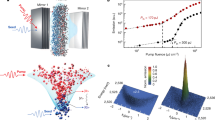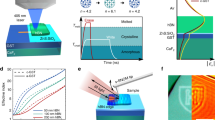Abstract
Active optical elements with ever smaller footprint and lower energy consumption are central to modern photonics. The drive for miniaturization, speed and efficiency, with the concomitant volume reduction of the optically active area, has led to the development of devices that harness strong light–matter interactions. By managing the strength of light–matter coupling to exceed losses, quasiparticles, called exciton-polaritons, are formed that combine the properties of the optical fields with the electronic excitations of the active material. By making use of polaritons in inorganic semiconductor microcavities, all-optical transistor functionality was observed, albeit at cryogenic temperatures1. Here, we replace inorganic semiconductors with a ladder-type polymer in an optical microcavity and realize room-temperature operation of a polariton transistor through vibron-mediated stimulated polariton relaxation. We demonstrate net gain of ~10 dB μm−1, sub-picosecond switching time, cascaded amplification and all-optical logic operation at ambient conditions.
This is a preview of subscription content, access via your institution
Access options
Access Nature and 54 other Nature Portfolio journals
Get Nature+, our best-value online-access subscription
$29.99 / 30 days
cancel any time
Subscribe to this journal
Receive 12 print issues and online access
$209.00 per year
only $17.42 per issue
Buy this article
- Purchase on Springer Link
- Instant access to full article PDF
Prices may be subject to local taxes which are calculated during checkout




Similar content being viewed by others
Data availability
All data supporting this study are openly available from the University of Southampton repository at https://doi.org/10.5258/SOTON/D0792.
References
Ballarini, D. et al. All-optical polariton transistor. Nat. Commun. 4, 1778 (2013).
Kavokin, A. V., Baumberg, J. J., Malpuech, G. & Laussy, F. P. Microcavities Vol. 21 (Oxford University Press, 2017).
Savvidis, P. et al. Angle-resonant stimulated polariton amplifier. Phys. Rev. Lett. 84, 1547 (2000).
Saba, M. et al. High-temperature ultrafast polariton parametric amplification in semiconductor microcavities. Nature 414, 731–735 (2001).
Nguyen, H. S. et al. Realization of a double-barrier resonant tunneling diode for cavity polaritons. Phys. Rev. Lett. 110, 236601 (2013).
Marsault, F. et al. Realization of an all optical exciton-polariton router. Appl. Phys. Lett. 107, 201115 (2015).
Sturm, C. et al. All-optical phase modulation in a cavity-polariton Mach–Zehnder interferometer. Nat. Commun. 5, 3278 (2014).
Amo, A. et al. Exciton-polariton spin switches. Nat. Photon. 4, 361–366 (2010).
Gao, T. et al. Polariton condensate transistor switch. Phys. Rev. B 85, 235102 (2012).
Cerna, R. et al. Ultrafast tristable spin memory of a coherent polariton gas. Nat. Commun. 4, 2008 (2013).
Christmann, G., Butté, R., Feltin, E., Carlin, J.-F. & Grandjean, N. Room temperature polariton lasing in a GaN/AlGaN multiple quantum well microcavity. Appl. Phys. Lett. 93, 051102 (2008).
Lu, T.-C. et al. Room temperature polariton lasing vs. photon lasing in a ZnO-based hybrid microcavity. Opt. Express 20, 5530–5537 (2012).
Kéna-Cohen, S. & Forrest, S. R. Room-temperature polariton lasing in an organic single-crystal microcavity. Nat. Photon. 4, 371–375 (2010).
Plumhof, J. D., Stöferle, T., Mai, L., Scherf, U. & Mahrt, R. F. Room-temperature Bose–Einstein condensation of cavity exciton-polaritons in a polymer. Nat. Mater. 13, 247–252 (2014).
Daskalakis, K. S., Maier, S. A., Murray, R. & Kéna-Cohen, S. Nonlinear interactions in an organic polariton condensate. Nat. Mater. 13, 271–278 (2014).
Dietrich, C. P. et al. An exciton-polariton laser based on biologically produced fluorescent protein. Sci. Adv. 2, e1600666 (2016).
Cookson, T. et al. A yellow polariton condensate in a dye filled microcavity. Adv. Opt. Mater. 5, 1700203 (2017).
Michetti, P. & La Rocca, G. Exciton–phonon scattering and photoexcitation dynamics in J-aggregate microcavities. Phys. Rev. B 79, 035325 (2009).
Mazza, L., Kéna-Cohen, S., Michetti, P. & La Rocca, G. C. Microscopic theory of polariton lasing via vibronically assisted scattering. Phys. Rev. B 88, 075321 (2013).
Coles, D. M. et al. Vibrationally assisted polariton-relaxation processes in strongly coupled organic-semiconductor microcavities. Adv. Funct. Mater. 21, 3691–3696 (2011).
Somaschi, N. et al. Ultrafast polariton population build-up mediated by molecular phonons in organic microcavities. Appl. Phys. Lett 99, 209 (2011).
Deng, H. et al. Quantum degenerate exciton-polaritons in thermal equilibrium. Phys. Rev. Lett. 97, 146402 (2006).
Maragkou, M., Grundy, A. J. D., Ostatnický, T. & Lagoudakis, P. G. Longitudinal optical phonon assisted polariton laser. Appl. Phys. Lett. 97, 111110 (2010).
Gadermaier, C. et al. Dynamics of higher photoexcited states in m-LPPP probed with sub-20 fs time resolution. Chem. Phys. Lett. 384, 251–255 (2004).
Schweitzer, B. et al. Spontaneous and stimulated emission from a ladder-type conjugated polymer. Phys. Rev. B 59, 4112 (1999).
Kasprzak, J. et al. Bose–Einstein condensation of exciton polaritons. Nature 443, 409–414 (2006).
Klaers, J. et al. Bose–Einstein condensation of photons in an optical microcavity. Nature 468, 545–548 (2010).
Kammann, E., Ohadi, H., Maragkou, M., Kavokin, A. V. & Lagoudakis, P. G. Crossover from photon to exciton-polariton lasing. New J. Phys. 14, 105003 (2012).
Lerario, G. et al. Room-temperature superfluidity in a polariton condensate. Nat. Phys. 13, 837–841 (2017).
Scherf, U., Bohnen, A. & Müllen, K. Polyarylenes and poly(arylenevinylene)s, 9 The oxidized states of a (1, 4-phenylene) ladder polymer. Makromol. Chem. 193, 1127–1133 (1992).
Acknowledgements
The authors acknowledge the assistance of T. Yagafarov in demonstrating the AND gate operation. This work was partly supported by the Swiss State Secretariat for Education, Research and Innovation (SERI) and the European Union's Horizon-2020 framework programme through the Marie-Sklodowska Curie ITN networks PHONSI (H2020-MSCA-ITN-642656), SYNCHRONICS (H2020-MSCA-ITN-643238), UK Engineering and Physical Sciences Research Council grant EP/M025330/1 on Hybrid Polaritonics, MIT-Skoltech NGP Program and the Russian Science Foundation (RSF) grant no. 18-72-00227.
Author information
Authors and Affiliations
Contributions
R.F.M. and P.G.L. designed the research. A.V.Z. and A.V.B. performed the experiments and analysed the experimental data. D.U., F.S., T.S. and R.F.M. contributed to the design and fabrication of the organic microcavity. U.S. synthesized the organic material. The manuscript was written through contributions from all authors. All authors have given approval to the final version of the manuscript.
Corresponding author
Ethics declarations
Competing interests
The authors declare no competing interests.
Additional information
Publisher’s note: Springer Nature remains neutral with regard to jurisdictional claims in published maps and institutional affiliations.
Supplementary information
Supplementary Information
Supplementary Discussion, Supplementary Results, Supplementary Figures 1–12 and Supplementary References 1–21.
Rights and permissions
About this article
Cite this article
Zasedatelev, A.V., Baranikov, A.V., Urbonas, D. et al. A room-temperature organic polariton transistor. Nat. Photonics 13, 378–383 (2019). https://doi.org/10.1038/s41566-019-0392-8
Received:
Accepted:
Published:
Issue Date:
DOI: https://doi.org/10.1038/s41566-019-0392-8
This article is cited by
-
All-in-one, all-optical logic gates using liquid metal plasmon nonlinearity
Nature Communications (2024)
-
Ultra-compact exciton polariton modulator based on van der Waals semiconductors
Nature Communications (2024)
-
Sub-picosecond collapse of molecular polaritons to pure molecular transition in plasmonic photoswitch-nanoantennas
Nature Communications (2023)
-
Highly efficient polaritonic light-emitting diodes with angle-independent narrowband emission
Nature Photonics (2023)
-
Shining light on turbulence
Nature Photonics (2023)



